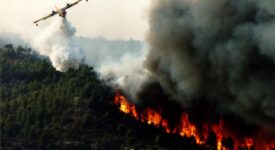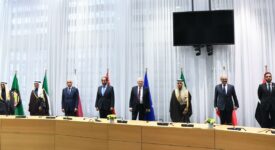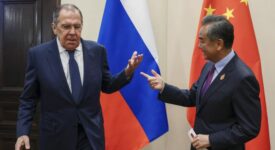Since 2011, Libya has been increasingly described as politically, militarily and territorially fragmented, lacking a strong central authority and solid national political and military institutions. In particular, the disconnect between political and military actors, that is the inability of representatives of transitional state institutions to exercise their authority on the armed groups on the ground, has proved detrimental to restore state authority. A multitude of armed formations, localised and split along different interests and ideological agendas, imposed their force in 2011 independently of the National Transitional Council (NTC), the political arm of the revolution.
That fracture was rooted both in the lack of a strong centralised national military, fostered by the regime of Muammar Gaddafi in favour of personalised militias, as well as in the nature of the external military intervention that brought to an end the regime in 2011. The intervention, indeed, crystallised the localisation of armed groups making the revolution more of a local rather than a national liberation struggle. In the following years, the elected state institutions and governments tried without success to impose their authority on these armed groups on a national scale.
This state of affairs had a negative effect on the safety and everyday life of the population. In 2020, an estimated 2.5m people had been most affected by the crisis, with 1.3m people having the most severe needs and requiring humanitarian assistance. This also explains the difficulties encountered by the UN throughout the mediation process. Bridging the gap between political and military actors will be key to bring back peace and stability in Libya and improve people’s everyday life, while ensuring that military actors remain subordinate to the political ones. In this context, the US, together with its European allies, should throw its weight behind the UN mediation process in order to strengthen it against the interference of regional powers and to ensure a more effective governance and transition of power in 2021.
In the aftermath of the 2011 revolution, political parties and alliances started to emerge in an attempt to develop the structures necessary for a representative democracy to function. 374 party lists and 130 political parties appeared ahead of the first legislative elections in July 2012. The National Forces Alliance and the Muslim Brotherhood’s Justice and Construction Party were the ones who rallied most supporters and votes. However, only 80 out of the 200 seats contested were assigned on a political party basis and the remaining 120 seats went to independents. In the second legislative election in 2014, the political parties’ quota was removed and only independents were allowed to run.
This reflected the diffidence traditionally fostered by the Gaddafi’s regime against political parties. The international community preferred to accommodate this tendency and the will of part of the Libyan political class rather than to encourage the establishment and participation of political parties that would have provided the basis upon which politics is run in a democracy. As a result, this propensity to revert to a politics of personalities, led by strong leaders that command their localities, quickly reappeared, reminding the seasoned observer of Libyan politics of the colonial era and independence. The major limitation of this system remains the inability to extend the local leader’s authority beyond his feud on a national scale reinforcing, instead, local patronage networks.
Furthermore, after the collapse of the regime, the transitional political actors never gained control of the armed groups. On the contrary, in more than one circumstance, they became hostages of these military actors. This was clear in Tripoli on the days preceding the passing of the controversial political isolation law, or on the occasion of the armed attacks on the legislative assembly in 2013 and 2014. When in the summer of 2014 the military confrontation escalated in Tripoli, there was little that the political actors in Tobruk or Tripoli could do to avoid a new civil war. By then, two main military formations had emerged: the Libyan National Army (LNA) in the east, a fragmented coalition of militias, tribal, and military forces led by the Benghazi-based Field Marshal Khalifa Hafter, and a multitude of Misratan, Amazigh, Islamist, and other western militias under the umbrella of ‘Operation Dawn’. For as much as their leaders stressed their unity, these armed formations were highly fragmented and localised. They battled against each other and among themselves throughout the years and until the ceasefire agreement in October 2020.
The conflict, together with the economic and governance crisis, and the impact of the COVID-19 pandemic, led to a deterioration or partial collapse of living standards and basic services, with a negative impact on the physical and mental wellbeing of ordinary Libyans. Today, more than 392,000 people are displaced across the country. This state of civil war and fragmentation would not have been possible without the support of external actors and, in particular, regional actors. The military support of Egypt and the UAE, for example, made possible several attempts by the LNA to gain control of the West and Tripoli from 2014 onwards. Although these failed, they empowered a military actor on the ground independently from the eastern political establishment. Meanwhile, after several clashes among armed groups in the West, the Turkish support for the armed formations in that region, since the end of 2019, created an opportunity to reunite the armed groups in Tripolitania but their relations with the political authority of the Government of National Accord (GNA) remain ambivalent.
In addition, in the aftermath of the 2020 US elections, regional alliances are shifting once again, and will inevitably impact the conflict. The Biden administration called on all external parties, included Russia, Turkey, and the UAE, to accept Libyan sovereignty and immediately cease all military intervention in Libya. It also suggested that it is vitally important to engage with Israel and the Gulf countries on the Iran nuclear deal. Meanwhile, the Gulf Cooperation Council brought Qatar back in the fold and Turkey reactivated dialogue channels with Saudi Arabia and Egypt. The visit of a high-level delegation of the Egyptian army in Tripoli, in December 2020, for the first time in many years and without objections from the Turks, is in itself an indication of a possible de-escalation in the Libyan scenario.
This is a precious opportunity to strengthen the ongoing UN-led Libyan Political Dialogue Forum (LPDF) to bring stability and peace to the country after years of civil war. The LPDF will have an important role to ensure a smooth transition of power until the 2021 elections. Indeed, not only it is for the LPDF to approve a government if the legislative assembly does not fulfil its obligation, but also it is to the LPDF to assess the progress of the government and the constitutional process and to decide on the legislation needed for the elections in 2021 in case of a new institutional stalemate. The change of leadership in Washington should help to facilitate this process and with it the reopening of a dialogue among regional actors. This could present Libyan actors and in particular the military ones, with a united international front that has been in the making since the Berlin Conference. It may be that after all, the end of the Libyan conflict will come as a result of a major geopolitical re-alignment.
‚Libya 10 Years After the 2011 Revolution: A Democratic Transition Unfulfilled‘ – Commentary by Karim Mezran and Alice Alunni – Italian Institute for International Political Studies / ISPI.







